#it helps me with using refs more often + studying anatomy
Explore tagged Tumblr posts
Note
Your art so surreal, did you take inspiration from African masks it’s amazing. You have probably gotten this question before but what’s your process and how do plan these beautiful pieces out. I am a beginner artist and would like some advice on how start doing digital painting.
thank you for bringing me back from the dead with your kindness, (i was so sad today ughhhh i think watching vampire diaries starting to affect me hjkhjk), i really, really deeply thankful that you spend your time to write something so sweet (also sorry it took me literally ages to reply phphp THE USUAL)
yeah, in buryatia shamanism like the big thing, so when i went to search what's out there in the masks department - google's mess of the results for once was helpful and showed this massive collection of beautiful african masks. the one that was inspo for tiisha lived in my head rent free for weeks before the character was even born phphph now i cant even imagine her without it
(here is little tiisha for you before i'll proceed to be not helpfull phphphph)

oof advices are not my strong side , like..........my process mostly is just sleep through the whole thing i guess..........................i very rarely do sketches, i hate study anatomy and perspective, drawing cubes makes me physically sick etc etc my approach to drawing were "fuck around and find out", always about chill and fun and barely ever about learning. imho thats why im so shitty at drawing simple things but not bad at coloring. so yeah, my biggest advice always and forever will be - be gentle to yourself, please
digital or traditional or whatever else is out there, dont forget you make it for yourself and for yourself only okay? it supposed to be fun, not sad tiring and competitive
advices for digital specifically tho - very objective, apply with caution
learn all the keyboard shortcuts, ideally to press them without thinking
explore more instruments than just brush. it will be tedious and sometimes feel like a chore so mb pick one victim once a month and browse youtube for a stuff like SECRET ULTIMATE TIPS ABOUT MAGIC WAND TOOL THAT WILL SAVE YOUR LIFE (they indeed will save your life)
check if your drawing program has artboards - turning it on will give you more freedom over canvas positioning and your refs will always be there and not in the separate window
idk about others but using auto tone, auto contrast and auto color often gives me well needed perspective on what im doing
in 99% cases be sure that you can reanimate even the most messiest artpiece you ever did. working in digital gives you the chance to mess with shapes, colors and perspective at any time so if you dont want to gave up on something - you absolutely didnt have to
from time to time while you are still learning - go out there in the wilds and search for the new brushes. tweak with them if you want. i have like ~500 and i use 6 max, but those 6 i found by at some point trying to draw with all of the 500
MADE. BACK UPS. and i mean not like save layers just in case before merging them (tho that's too will help) no, i mean click SAVE AS once an hour and create A NEW FILE. PLEASE. i lost so much stuff to sudden power outage. its never pretty and you loosing will to work for days
watch at least one tutorial about the whole rgb srgb and cmyk thing - i did, understood not a thing, but at least im not playing dora the explorer with my colors after the export now
uh idk think thats it? tried to think about those that id hope i knew when i started so hopefully something will help
have fun with your drawings!!
62 notes
·
View notes
Text
How I draw: Use of references
Second response to a few art questions from @johnny-and-clyde let’s gooo!
I love references! Like most artists I did have that phase where I thought I was better than everyone because I didn’t use ‘em, but lemme tell ya- starting to use references took my art from this

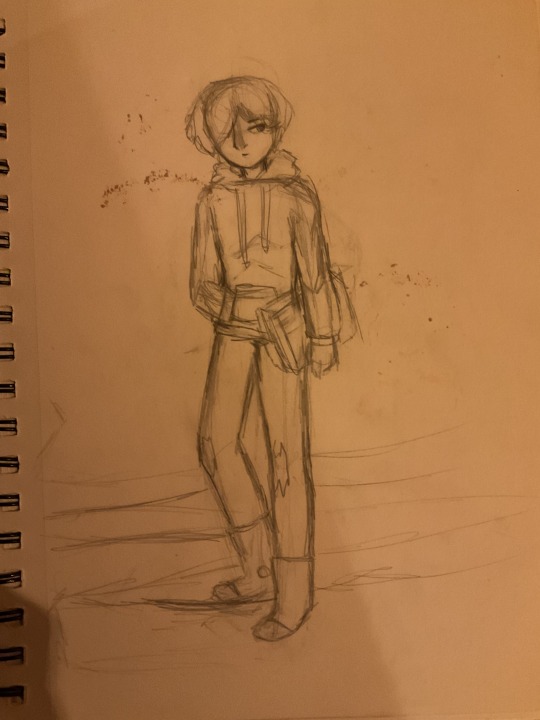


(Art from 2021-2022) To some better lookin stuff, and eventually to the stuff y’all know me for now lol!
Nowadays I do use references for almost every drawing, but the amount that I reference them varies Occasionally it’s pretty direct, like my drawing of Curly Shepard, in which I HEAVILY referenced a photo of myself for the pose and fit:

(I don’t dress like this on a daily basis the pic was taken at a Twilight-themed school dance ok) (I’m not cool enough to wear that many necklaces w/o a good reason 😔)
In drawings where I directly reference photos that don’t belong to me, I put the reference in the post under the drawing, so folks know I didn’t plan the concepts/compositions on my own. But usually I don’t directly reference things…
Usually I use a bunch of different references for a bunch of different things. This is for two purposes:
1- Making sure everything stays vaguely anatomically decent, that the fabric folds in the right places, that the perspective works, that the lighting looks good, etc…especially in tricker/unusual poses. Um I’m also pretty sure that I might have some form of aphantasia, or at least a really weak “mind’s eye”, which is probably why I struggle with composition/planning in art and why I do so much better with references
Like here, when I used this pic of Emilio Estevez’s character in Repo Man to make sure I was getting Mark Jennings’s face shape right- just glanced at it off to the side and (more or less) drew what I saw


Or here, in this pic of Steve Randle- I didn’t know how to even start to draw the angle I needed, so I took a pic of myself and used that

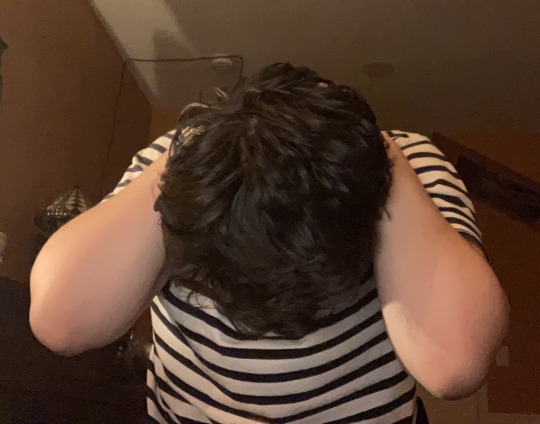
2- Capturing the likeness of a person. For most new characters I draw, I take a bunch of screenshots and roughly redraw them and occasionally trace them to build muscle memory, all while taking little notes about unique features they have. Then, once I have a feel for them, and enough odd-looking line drawings to look like a crazy stalker, I’m ready to start actually drawing post-able art yk?
Here’s an example from 2023 where I studied Nancy Wheeler. Final product ain’t fantastic, but this was two-school-years ago so it’s basically ancient in my book lol


I do still use refs often in the finals, but less directly and with less adherence
But I will say, for rougher/cartoonier drawings I don’t use as many refs. Like, I didn’t use references for these (although I did pose in the mirror to get the arm right in the self-portrait lol) :

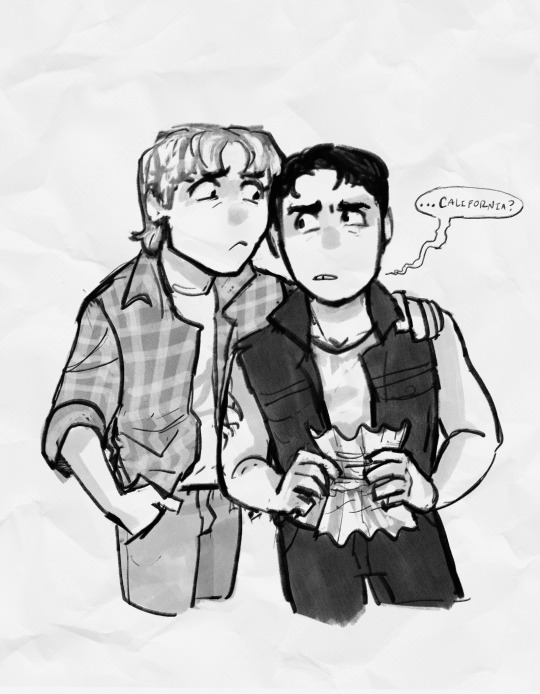
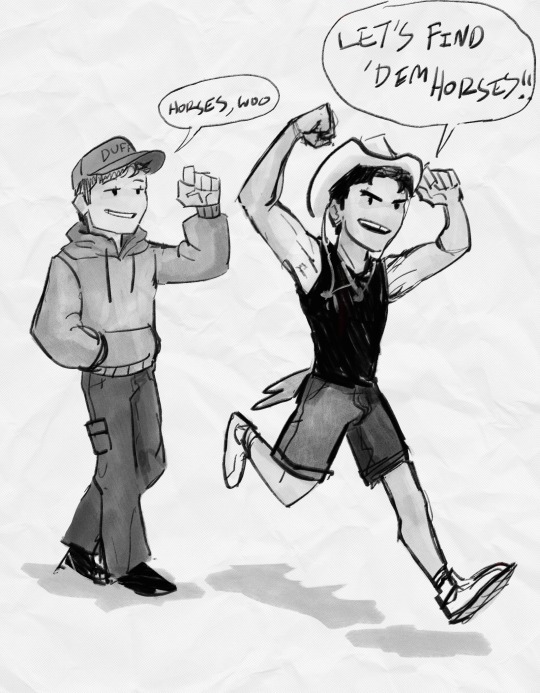

Lastly, I also find it’s nice to have a mirror/window nearby to look at my own anatomy and reference that, although that’s mainly just useful for characters who look semi-like me/have similar builds to me lol. Like I can reference myself for drawing Steve Randle or Johnny Cade (at least his face lol), but not so much for drawing like…Dally or Evie or Marcia. Still, it’s useful, especially when I can’t find a specific reference I want, yk?
Anyhow, those are the main ways I utilize references in art! Hope some of this was helpful :))
#ask#how i draw#digital art#art tips#rambling#long post#will answer the hands question tomorrow probably?? It depends lol
27 notes
·
View notes
Note
Hi, everything’s been good. Out of curiosity how did you learn to draw the turtles, especially when it comes to their facial expressions and bodies ? Do u have any tips or references that could be helpful ?
Hi, things are going relatively good. Hmm, I'm probably not the best person to ask this, heh. My drawing progression and process has been (and is) a bit all over the place.
For anatomy, I'd recommend searching for terms like "comic book anatomy" and "simplified male anatomy for artists". Some pretty good free resources out there, especially on YouTube. Then you look at those recourses and simplify even more! I don't draw a lot of muscle detail, just focus on making the main muscle groups visible and ignore the rest. As long as that's in place and you have alright proportions (another thing to study, hooray), things tend to look passable.
I also have a little folder of screencaps from the movies (mostly OOTS), always handy! Some taken my self, some "stolen" from here on Tumblr. I've never really used refs for expressions, but I also don't draw a lot of very exaggerated/cartoony expressions. I keep it subtle and often find my self subconsciously making the faces I'm trying to draw, heh. And I guess that's my final tip: Draw! One can't JUST look at YouTube videos and tutorials, you gotta draw a lot too. But never be afraid to use references, that's how you learn and drawing is how you hammer that knowledge in to your hand!
Don't be afraid to ask if there's something more specific you're wondering about or if you want me to red-line something. I find that easier to be helpful with. I'm not a very good teacher on broader subjects, my answers to those tends to boil down to: JuSt GoOgLe It, sorry, haha.
29 notes
·
View notes
Note
so enamoured by how u stylize anatomy and stuf … do you have any sort of tips or pointers for practicing/improving initially ;;
Hehe thank you:)!
Do not be afraid to reference/trace from your inspos. Draw the same poses as they do, i recall watching livestreams from my inspos and 1 being in awe at how fast they drew 2 studying every stroke they did, how fast, how they connected lines...helped me stylize my anatomy a whole lot!
The connection of those lines is very important for anatomy, especially. Things line up more often than you think they do! Id be specific but really it applies all over the body
Do some peoplewatching! Watch videos of people showing skin so you can see what muscles look like at this angle that angle Etc... A pose i often see done incorrwctly(ive messed it up before myself. Tend to overthink.) is when arms are raised high up above a chars head. Looking at refs and People Doing that pose will be your saving grace for trickier-to-envision poses like that.
Use yourself for reference. I still do this when i do angles with hands. It is always embarrassing to be caught putting the thumb on the wrong side of the hand. Though it applies anywhere else!
Thats about all i have in mind!
#Use my art for reference if youd like! Though if its traced id rather it not be posted at all. Im pretty confident in my Anatomy abilities.#asks#i felt like 'use references' would be generic advice so i tried to be more specific!#gooptalks
14 notes
·
View notes
Note
Genuine question, where did you learn to draw? I get that tons and tons of practice helps and all that but where did you learn to understand coloring and shading and lighting and anatomy and all that? Did you watch certain youtube videos? did you take a course? Did you go to art school? did you read certain books?
I adore your art, by the way. You are awesome. Have a good one.
thank u so much for your interest and for the compliment! this is gonna be a bit long but bear with me
im mostly self taught, however ive had the privilege of going to art school (animation and digital arts) + i got a full scholarship to take a masters degree in concept art and storyboard, so its really been a mixture of both. ive been lucky enough to have great teachers along the way, but the "tons of practice" is like 90% of what will make you a good artist
i think the most valuable part of art school is the people you meet / the networking. not everyone i went to school with had talent or even drive, and many talented people i work with today didnt go to art school. art skills can be learned by anyone, but it does take a lot of time and effort.
about my specific experience when learning skills like color, lighting anatomy etc :
color:
i used to be very scared/intimidated by color, but what made it more accessible were those color pallette challenges from back in the day, where people would pick a pallette and a character and you had to make it work. so, in this case limitations helped me undestand many things.
i still dont feel like i have the best grip on color theory yet, my use of color has always been very intuitive which is not the best. however having a color wheel is always handy. This one is my favorite. It even has options as to which kind of combinations you can use (Triads, Complementary colors, Adjacent, etc,). using the color wheel is a way to ensure your colors are always in harmony.
shading/ lighting:
lighting is quite the topic. i had a teacher who was a director of photography for stop motion and he mostly taught us traditional photography terminology such as this. The same terms and concepts apply to painting, so getting familiar with these can help you understand different kinds of light and what theyre commonly used for.
studying the masters is a must. throughout art history there have been artists that became legends for their specific and often disruptive use of lighting. off the top of my head, some artists that master lighting are: rembrandt, joaquin sorolla, vermeer, john singer sargent, maxfield parrish, caravaggio, etc. There are many excellent contemporary painters, if it's any help, i like to collect ref and inspiration in my insp blog.
animation color scripts can also help understand how to sythetize light in drawing AND especially to use lighting to evoke emotion.
anatomy:
there are a trillion options on studying anatomy from books, which i feel are very helpful when you need to understand how bones and muscles work. I dont have a particular rec for this, but most are accessible in bookstores/libraries and will give you a decent notion of the mechanics of the human body. same goes for animal anatomy.
anatomy is one of the fundamentals that you need to practice most. figure drawing and gesture drawing are two great ways to practice. theyre not the same thing, but complementary. figure drawing focuses on anatomy, proportion, line of action, while gesture drawing focuses of the action of a person (what they are doing, how they are doing it, and what they might be feeling while doing it).
a live sketching session with a model (preferably nude) is one of the best ways to learn, however this option is not very accesible so here are a few alternatives.
going outside and sitting at a cafe, at a park, airport, public transport or any public setting where people gather is a great way to practice. since people are always moving and shifting, this tecnique will make you focus on drawing loosely and quickly. and after a few sessions youll notice you start to focus on capturing the essence of the pose, the proportions and the general gesture of the person youre drawing. this will help you synthesize better and quicker.
another thing that works well (and is even more accessible) is sitting down with your sketchbook or tablet and sketching times poses from Line of Action, its quick and easy and even 10 - 15 minutes of practice a day will make your anatomy skills improve a lot.
A few useful books (these are animation oriented, but art fundamentals nonetheless) :
Color and Light by James Gurney
Framed Ink + Framed Ink 2 by Marcos Mateu-Mestre
Layout & Composition for Animation by Ed Ghertner
How to Draw a Character The Foolproof Method by Soizic Mouton
The Complete Color Harmony, Pantone Edition Expert Color Information for Professional Results by Leatrice Eiseman
Learn from 100 Famous Artists by 21 Draw
How to Draw drawing and sketching objects and environments from your imagination by Scott Robertson and Thomas Bertling
The Character Designer by 21 Draw
The illusion of life Disney animation by Frank Thomas, Ollie Johnston (this one is mostly abt animation, but having an animation background can influence the way you draw, so depends on what you want)
The Silver Way Techniques, Tips, and Tutorials for Effective Character Design by Stephen Silver
100 Tuesday Tips by Griz and Norm
i have most if not all of these in pdf, if anyone's interested i could send a .zip with the files via email :)
i hope this helps!! if you have any other questions im happy to answer! happy drawing!
7 notes
·
View notes
Note
Maybe you have some drawing tips for beginners?
Your style is incredibly beautiful and it just inspires this thing inside me to grab my iPad and start drawing but unfortunately I have no idea where to even begin
Or maybe you have some recs where to look to learn how to draw stuff?
But I understand completely that it’s your thing and artists should never feel pressured to share all their techniques and secrets, you worked hard on it!
I just really really love your art to the point where I just look at it for 30 minutes straight with this big feeling in my chest
<3
ah it was never about being secretive, i'm pretty open about my drawing process since gatekeeping knowledge is a big pet peeve of mine. It was more like,, laziness because writing a cohesive and helpful drawing tutorial is pretty difficult and i wouldn't even know where to start; i'm afraid i'll get maybe too technical and what have you.
As for tips for beginners, i've shared plenty on my couriouscat so you can scroll through the answers there, i also have some drawing timelapses on my twitter account as well (albeit you'll have to scroll a little)
I'm very flattered you feel that way about my art, it really means a lot to me and i'm glad to have inspired you to draw as well that's awesome and i wish you best of luck!
I actually don't know how different drawing on an iPad is compared to a graphic tablet+desktop, so I am actually pretty clueless in that regard. I think Procreate is the most used digital art app for iPad so you can start by getting it and familiarizing yourself with the UI. I think this step is often overlooked. The brushes and the chosen program can make or break the drawing experience. If you simply find yourself not enjoying Procreate, experiment with other apps or maybe try switching to a graphic tablet, maybe that feels better and is more suited to your tastes.
To be completely honest, one "bad" piece of advice that i should probably keep to myself is to draw something you actually enjoy: fanart, Pretty Girl Portrait(tm), your cat, landscapes etc even if it's above your skill level (becoming obsessed/ fixated on some character from a piece of media also works wonders i'm just gonna throw that out there). The main point is to actually care about your chosen subject in order to get inspired and to have that inner desire of "doing them justice" aka drawing them well. The traditional art learning route probably involves studying the fundamentals, shading spheres and cones and simple 3D forms blablbablah which. Yeah ! sure that's probably better advice but i'm telling you what will make you want to keep going and not get discouraged after a few failed attempts.
As for the drawing subject, I highly recommend having photo references to guide you.. you always need refs it's a recurring thing. My fastest artworks are the ones where I have the right references. the less references the more difficult it is to draw something
As a beginner it is also a good practice to draw OVER your photo reference to get the proportions right ( i'm not talking about literally tracing the contour of a face or limb ( just an example ), but moreso identifying the Main shape which makes up that body part and observe how long is it in respect to the other components, how does it connect to the other parts etc - big difference. Tracing won't help you in the long run).
Another thing you can do is to study your favourite artists and see how They tackle whatever it is that you like in their work. how do they simplify facial features? what about anatomy? color/ light etc and kinda reverse engineer your way through their process. ( but i highly recommend to just keep these practice sketches to yourself, and to not share them on social media- unless you get the artist's permission)
This is how i got into drawing and what i did back then, again, for more technical hands-on information i did answer similar CCs before so with a little bit of stalking you'll find them in no time
I wanna finish this with some resources that helped me:
>youtube guys - sinix, ahmed aldoori, marco bucci, and also just speedpaints in general i highly recommend watching those
>for simplified anatomy i found @/ taco1704 's ref sheets to be very helpful but ........... I'm pretty dry here i just look up refs on Pinterest tbvh
speaking of, here's my pinterest i have a bunch of art related boards board cool stuff overall maybe they can help guide you towards some direction or inspire you in some way idk
ok i kinda suck in the resource department listeN. im starving too just.................. watch youtube speedpaints ok
SORRY IT'S SO LONGGGBGGG i hope it was at least a bit helpful? this was all over the place... I'll try to come up with a tutorial as well but i really gotta be careful with how i go about it. I'll leave you with this for the time being. Again, thank you a lot for the kind words, I really am very grateful and touched esp by that last part about staring with the big feeling stuff eeeeeeeeeeeeee really wow T T that's so lovely and a big compliment thanks ty ly
#long post#this is so messy...... sorry anon#i don't have a very. linear thought process as the kids would call it#you should see my lit essays back in the day lmfao#anyways#if there are typos i'll fix them later#ASK IZTEA#they call me the tutor the way rial my way through the .....#ok nevermind
36 notes
·
View notes
Note
How did you learn how to draw anatomy? And if you use any references do you have links for good sources? I want to get better at it but i find it hard to get good reference images
references, trial and error, sheer determination, and my whole drawing journey across my entire life. for sources, there are many many options but for me personally i never enjoyed doing studies. though theyre helpful, i like to learn as i go, so the refs i compile are usually multi purpose (they have a cool pose going on, or interesting lighting) and learning anatomy is sort of a secondary result of all that.
but for sources - i get a lot of pics off tumblr (you can see what kinds of images i find useful on my inspo blog @morningprince), i also save hordes of images onto my pc and phone if i see anything remotely interesting while using the internet casually. pinterest is great for sorting reference types with personalized boards, and google when you cant memorize how to draw ears, no matter what, no matter how many times you draw them (hi). there are also anatomy textbooks you can find on the internet with a little digging but ive never cracked any of these open, because again, i like to just learn as i draw, and if i run into something i dont know how to draw in the middle of a painting i'll often try to look up a ref for that specific thing on the spot.
and when you absolutely cant find the reference you need in the middle of a drawing, use your own body. the amount of awkward pics i have of myself that i forget to delete when im done using them is unspeakable. if i ever lose my phone i hope whoever finds it enjoys the plethora of totally unsexy tit pics of me on here
but yeah i feel like ive been very slow with my anatomy journey when you look at how long it took me to get here. all i can really say is dont give up, and try to have fun with the challenge of learning. the few times i have done studies i liked incorporating my fave characters onto the geometries (being into spiderman really helped as an excuse for trying some more flexible poses back in the day). i believe in you!
87 notes
·
View notes
Note
I follow you on twitter & all I gotta say is, I love the diversity in your drawings so much, I hate when people make girls all stereotypes & your art makes me feel so comfortable it’s like a warm feeling not to mention your nsfw art. It doesn’t just show the list it shows the love & affection each character has for eachother it shows how intimate & hot the moment can be but also sweet? I’m not sure I love your art too much it really makes my day to see it, but any tips on anatomy?♥️
thank you so much!! i totally get what you mean by a list, that really is what diversity can feel like sometimes. my weight and figure have fluctuated so much over the years and i've gotten enough shit from family about eating habits and how chubby i've gotten, to the point of dysmorphia, and turning to art (and not to mention seeing the vast majority of fat butch rep) to remedy it has done wonders for my body image, and i'm really glad people like how i do things.
in terms of tips, as someone who went to school for this sorta thing, i'm gonna try to make this as accessible as possible aka free resources.
timed figure drawing!
legit, you gotta draw naked people posed in intricate ways. there's literally no avoiding it, you have to draw from life and not from tutorials. obv, i'm not saying go out and attend a life drawing course -- that's expensive shit -- so here's a few options:
i use a site called quickposes, since most figure drawing galleries require subscriptions.
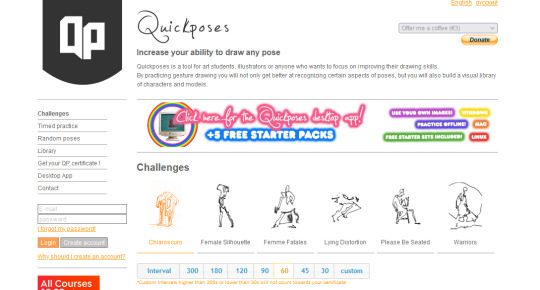
you can set a timer for how long you want on each pose/reference. i recommend challenging yourself with shorter times as it helps you to get rid of any hang-ups about getting the anatomy exactly right. the drawing's got to get done by the end of the timer, don't focus on the details. just draw, be done with it, move on to the next drawing.
there's also a youtube channel that we'd use in class when a model couldn't show called new masters academy and they have a bunch of timed daily drawing exercises.
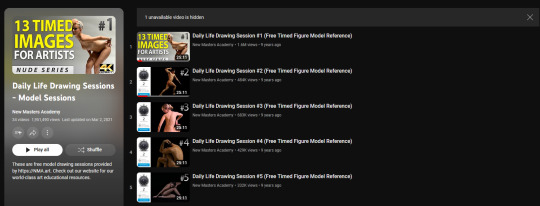
as a general rule, don't lean on the amount of time you have. what you're wanting to do is get a FULL PICTURE on your paper as soon as possible, regardless of a long or short time. get the full figure onto the paper then use the rest of the time to fuss over details, shading, editing, etc.
do studies!
kinda similar to the last one but in the more time-consuming sense.
use pinterest. it has a lot of uses for a lot of things but i use it quite a bit for both anatomy refs and costume design inspiration. this is legit what my home page looks like now because of it.
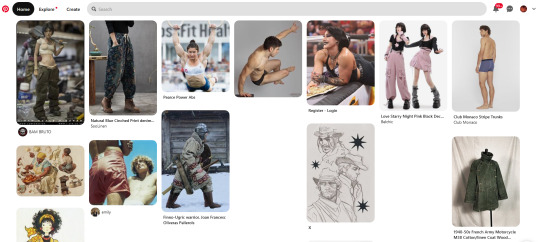
here's a board i made on anatomy, pulling from different body types; obviously i get a little gay wid it, but there's a verrrryyyy clear lack of certain body types in a lot of body refs like muscular women, fat women, just overall people who higher fat content than the lean, almost 0% fat of the figures seen in most tutorials and galleries:
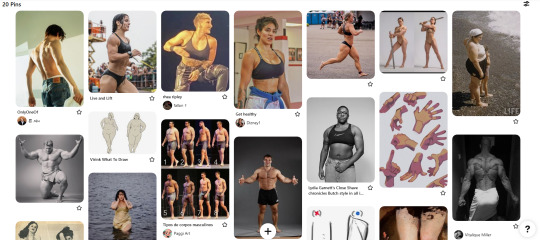
this is where pinterest really shines because you can find literally everything on it.
in particular, there's an account called character design references, that is basically a stockpile of references for artists. i wouldn't normally recommend artist tutorials when it comes to wanting to learn anatomy because it can get a little echo-chambery (side-eyes the male vs. female tutorials that float around on twitter all the time) but there are actually some boards that have genuine studies on the human form, even from a medical point of view.
LITERALLY JUST DRAW A LOT.
I CANNOT STRESS ENOUGH IT'S GONNA TAKE A LOT OF TIME AND PRACTICE TO GET TO A CERTAIN LEVEL OF SATISFACTION.
like that's it, full stop, draw often. if you're feeling rusty, go back to basics. if you're art blocked, go back to basics. if you're bored, go back to basics.
#ask#anatomy#anatomy tips#talkies#drawing should be about having fun first and foremost#i find figure drawing fun because of how quickly it gets done#art advice
16 notes
·
View notes
Note
Ur strength is definitely color and line work. Something I would say needs some work is definitely your full body drawings and poses. Your poses are always static and rigid and (especially when in motion) it takes me a moment to figure out what the character is supposed to be doing. Your anatomy is fine, its the stiffness of the over all pose thats the issue. It makes your pieces lack energy and any real umph. Your beautiful use of color and line usually covers for this but for me (someone who also struggles with this) it pops out like a sore thumb.
To practice, id suggest doing gesture drawings (1 minute sketches of action poses) to really understand how the body moves fluidly and to practice capturing that energy. Id also suggest doing 5-10 minute studies of full body figures in which you specifically observe how the pose affects the distribution of weight. How the torso curves in relation to the pose (your torsos are often very vertical and stiff) and how their muscles, fat, and clothing stretch, bulge, or fold depending on the pose.
Try to keep things loose during these studies and focus on capturing the energy of the pose over perfect anatomy. Focusing on anatomy can often be a distraction and can actually detract from capturing the fluid movement of a pose when you are first learning. You dont want to be thinking about anatomy during a 1 or 5 or 10 minute study if that is not what you are trying to learn.
While doing gesture drawings, its important that you move fast and dont get hung up on details. Get the line of action in there and the general shapes of the figure. Focus more on the movement of the figure over anatomy or details. Feel the rhythm in the pose and do your best to capture it. Id suggest doing 10 or 20 of these at a time. Sites like Line of Action are great for studies like this.
For 5-10 minute studies you want to build on the rhythm you developed during the 1 minute studies. Again, you want to focus on the movement of the pose over the details. Keep shapes simplified and force yourself to think in the abstract. A vibe i get from looking at ur art is that you get focused on the small details while losing sight of the big picture (might be wrong bout this but its something i also struggle with lolol) so during studies its important to keep ur mind on the bigger picture. Focusing in on small details adds to the stiffness of a piece as instead of one singular piece, it’s made of many smaller pieces. Idk if that makes sense lololol. Id do 1 hour of these 5-10 minute studies.
But yea id say this is really the main thing holding you back right now. Once you figure out how to capture the rhythm and energy in a pose id say ur golden lololol good luck! I hope this helps XD
oh gods yeah I need to whip some referencing for poses and specially dynamism, I tend to make things a bit too stiff. I think I cornered myself into making very static poses since I do a lot of character ref oriented work, and showing the design and outfits is a priority over the dynamism, and like, I need to get working on that.
It sucks to realize how I've let social media performance guide a bit on what I draw and I practice. People like their fullbody character designs with a grey background, and I've let a lot of What Isn't That fall apart, and it's bad! I gotta get better!
I need to find a way to maybe get a way to do these practices and still post it, bc even when I've done them, they stay in a folder and never get to see the light of the day. (Also, I saw the other ask and I'm gonna check that one soon! I struggle so much finding good refs for that!)
13 notes
·
View notes
Note
if it’s not too much to ask and if you can and want to could I get an outline of how you draw bodies as reference please ^^

*eats ur art* That’s what ur art tastes like ^
First of all, thank yew 😋, and of course! (Not sure how helpful this will be tho cuz a lot of the time I'm just winging it. You don't have to follow this to a t, it's just mostly tips and what I use.
Basic shapes
I don't really follow these sometimes because it often depends on the general aspects of the character I'm drawing, but it's relatively the same


I mostly use triangle sort of stuff for the chest and small bowl shapes for the rest of the torso till I get to the pelvic/hips which is like a bump and then triangle down (??). The arms and hands are what I bend to my will the most and ignore the anatomy on mostly. I just mainly keep it mind that the arm is like half flat half bump when straight out. Even when in a pose, there's always a flat part to the arm.
Ex: 1

See how I kinda used that with this one?? Idk but like that's basically how I do it using shapes. But I also do it another way with the collar bone
Ex: 2

Okay so with the collar bone, basically I start with the head and maybe the triangle torso shape. Then I draw the collar bone and connect everything to that. Ex: the arms are connected to the shoulders, which is connected to the collar bone, which is connected to the torso, which is connected to the pelvis, which is connected to the legs.
It helps in a way tho I've been told before that's a pretty inconvenient way to do it soooo 😗 do what you will with that info
References & studying
I didn't study shit. Deadass. My biggest helper was my gayness and muscular women

I would just stare at muscular women for ages on Pinterest till I realized that their muscles are VERY visible. Like in an anatomy way.
Ex:
Basically, I would map out muscular women and take in what I could exaggerate and stuff to my style.

I also kept in mind how muscles look on different bodies, but how they're all the same muscles no matter. So I was like "they all have the same muscles, just some more defined and sharp, other less so" AND BOOM :D it was like the pearly gates of art had opened for me.
Sketching
I sketch in 3/4 ways

Outline is when I would either trace my ref or do a small stick man of what pose I want, then define on that.
Shadow is when I basically do a filled outline of what I want my end product to look like without any details or fill in a ref and use that as my base for what my end product should be similar to.
Raw dog is when I just go in, no ref no outline no nothing, and just draw what I'm thinking. It's a process of draw, erase, and draw till I sort of can tell what I'm thinking of. This is often the process I use for fanart. Just ref if the opposite of that. It's when I trace the ref and just the ref. No added details, no change of clothes, expression, no nothing. I often do this when artblock hits.
Bones

Bones are friends, not foe.
I only really pay attention to the shoulder, rib, and neck bones. Sometimes the pelvic but often I let the other bones float to the back of my head. This just helps with knowing the limits to the bends of a body and stuff. I keep these in my a lot when drawing.
#sorry this took so long to reply 😭 this took forever#hope this helps tho cuz like idk how to explain it#i like learned how to do it and just never thought about it further#i was like “okay i know it now” and never remeberwd how i learned it#:D 👍🏾#my art#art#drawing#sketch#art tips
4 notes
·
View notes
Text
How I draw: Proportions/sketching
The first response to a few art questions from @johnny-and-clyde :))
sketching:
So I honestly used to be a lot more…intentional about my sketching?? Up until a few months ago I would draw out actual sketches that I’d then cleanly ink on top of in a separate layer, like this:


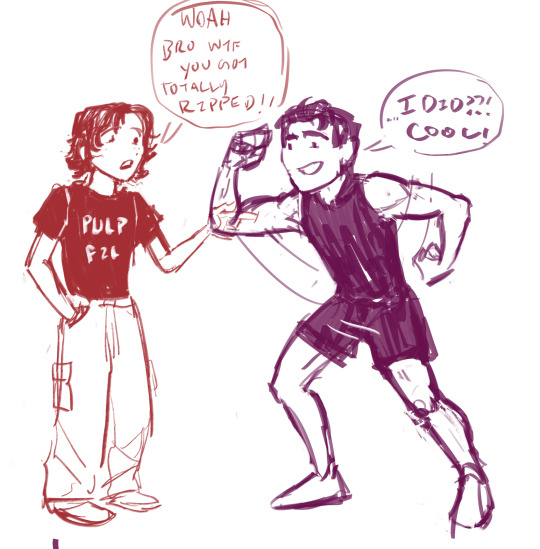

I’d try to keep things loose and easy, but I’m not fantastic at that lol
I have a tendency to over complicate sketches- It’s not super obvious here, but I did semi-map out the anatomy under the clothes and fabric folds. That’s probably a good thing to do, generally, especially since I was and am still learning anatomy.
I don’t do it much anymore tho, because I often got caught up in little details that just wound up covered by clothes 😭 So I generally focus on mapping out the clothing shapes over the proportions/ anatomy. Definitely study anatomy anyway tho- this only works for me nowadays because I did and still do study anatomy a lot lol
These days though, I don’t r e a l l y sketch that much. I mean, I do- but instead of making another layer and inking it, I kinda just clean up the sketch the way I would if I were using pencil and paper. I don’t have a lotta example images of this, because it goes from the sketch to the final lineart in one layer?
tried to reverse-engineer it here on this Angela drawing. idk how helpful that is tho lol.

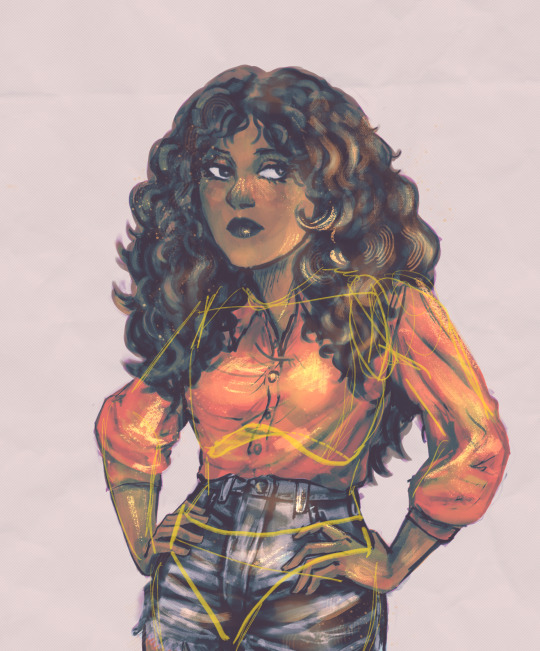
Idk, most important thing for me while sketching is remembering that everything has a 3D form, and also to FLIP MY CANVAS FREQUENTLY so that it stays balanced lol. -also- I almost always take note of the ribcage, the clavicle angle, and the hip angle when planning poses
-And I consciously try to keep things from getting stiff, and think of the pose as an intentional composition. I actually struggle most with plain standing/walking poses, because I very often can’t think of ways to make them look…idk, interesting? That’s why it’s taken me so long to finish pt.2 of my Outsiders character designs- I can’t find good dynamic-but-also-stagnant poses for them
proportion:
Honestly man idk I just sorta say “fuck it we ball” and hope for the best. I used to think a lot more about this one but as it’s become more and more natural to me I become less and less able to define/describe it?? I dunno lol.
My art style is semi-cartoony, and honestly kinda inconsistent in terms of proportions. I generally aim for the hands to be similar in size to the face, and for the shoulders/chest area to have enough space to fit the clavicle…but none of this is really a conscious decision? It just sorta happens. The heads/eyes of my characters are usually stylized, and so the hands end up a bit bigger to match the faces, and I tend to exaggerate muscle mass but not really muscle definition…And I also stylize things for characters to better contrast each other. For example, I’ve noticed I draw Steve Randle stockier/bulkier than he is to better highlight Soda’s slenderness.
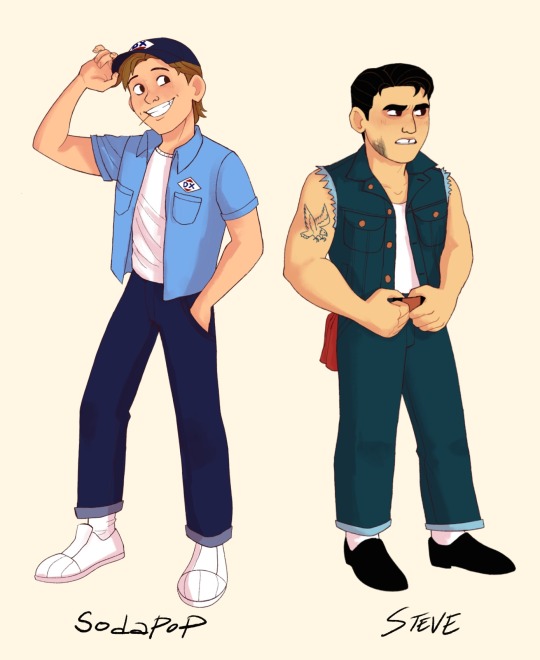

(see how they’re not as drastically different in build as I draw them? Steve seems bulkier mostly cos he’s shorter but has a similar amount of mass I think) (don’t quote me on that tho idk how to put this shit into words lol)
I have a pretty decent idea of how proportions are supposed to work from years of studying them, and I have no idea how to explain any of it. Just…do a lot of figure and gesture drawing, use a lotta refs, and it’ll make sense eventually 😭
#ask#how i draw#digital art#art tips#rambling#long post#< I mean not very long really but yk just in case
51 notes
·
View notes
Text
Very happy I can just make creatures and put em out there for people to enjoy
#loveposting#diving back into a dormant special interest is completely making me feel way better#I am super excited about things again#Thinkin about brynn metheney....terryl whitlatch....jay eaton.....jon conway.........darren naish................#Seeing the stuff about the almost real zine completely REIGNITED that sense of fun and exploration that comes from specbio#Like dude without that boost I wouldn’t be thinking about all this rn#Thank u jay eaton#I know you will never see this post ever but I’m glad you and your crazy cool work exists. Keep on being awesome#sleep rambles#I love drawing a creachur#it helps me with using refs more often + studying anatomy#so good and fun#gonna re-read terryl whitlatch’s books#maybe listen to tetrapod zoology again after *checks watch* at least two years of not doing that#oo and listen to interviews with creature designers#hell yeah#full force brain worms babey#I also tweaked and added some dnd mechanics that feed DIRECTLY into this interest#OH OH OH#MAYBE I MIGHT REVIVE THAT TTRPG I CAME UP WITH LAST YEAR#Thrive is HUGELY about specbio and I think I could trick it out to be more playable/fun#I’ve said this about thrive before but if y’all wanna hear about it sometime I am SO DOWN to rambles about it#anyway goodnight it’s 2:34 am atm#love y’all
6 notes
·
View notes
Note
Do you have any art tips? Also, What platform do you use for your art?
ngl, i feel kind of silly giving art tips because i really don't know anything lol and my skills are still very Underdeveloped. but here is what I've found most helpful as I've been trying to improve. (these are more general tips rather than specific technical tips—hope that's ok!)
Oh and I use photoshop and a Wacom intuous tablet :)
Use references! I look at references with pretty much every single thing I ever draw lol I’m incapable of drawing purely from my imagination 😭 but using refs is good practice anyway. Sometimes I draw things based on a single reference but often I end up using multiple references for one drawing.
Study art that you like. This has been huge for me! I’m constantly staring at other people's art both out of admiration and for education haha. When I discover an artist whose style i really vibe with, I like to try to break it down and pinpoint exactly what I love about their art and what their strengths are so I can maybe try to incorporate it into my own art. A few of the ones I've probably studied the most are @bugaboo-n-bananoir @anna-scribbles @jooitshere @shishitsunari @celerydays @picayunearts @leviaana @masilvi @buggachat @ladyblargh @yunyin @sabertoothwalrus — all super skilled and talented and i learn a ton just from enjoying their art!
Draw what you want to draw. I don't often draw things just for practice—I draw things because I feel like it. So instead of saying, "Man, I have to practice drawing X thing until I'm really good at it, and then I can finally draw the idea I have," I say, "Okay, I want to draw this thing and it's kind of out of my comfort zone and I don't know how to draw it but I'm going to try to figure it out and learn as I go." This might seem kind of backwards so hopefully it's not terrible advice lol but I've personally found it to be a helpful approach. Drawing purely for practice will definitely help you improve and is probably the method recommended by 9/10 dentists, but I am the 10th dentist who says, "nah i'm just gonna do what i want" alsfkdafj. My skills are limited but I don't want that to stop me from trying stuff, and it's in the trying that I improve. Basically, all the drawings I post are my "practice drawings." Because almost everything I've posted (unless it's like a headshot at a 3/4 angle asdlkfjasjf) was out of my comfort zone a bit and I was not confident i could pull it off but I just tried and worked at it until I thought it looked ok lol
Don’t worry too much about “style.” I feel like a lot of artists (including me) overfocus on finding/developing a consistent art style, but I think it’s better to just draw lots and build your skills and have fun! Your art style will come through naturally as you do that. Also, there’s nothing wrong with variety. Not all your stuff will look the same, and that's okay. And chances are that your style looks more consistent to other people than it does to you. Even if your drawings look different, they’ll all still have your fingerprints on it and feel like you :)
Give yourself credit for the things you create. It's so, so hard not to compare and get discouraged. Everyone suffers from art envy and gets frustrated with themselves—I definitely do—but it's really important to be patience with yourself. Growth is not a linear journey. There will be ups and downs, and that's okay. I probably get the most frustrated with myself for struggling with anatomy/full-body drawings and for taking a million years on every simple-looking drawing lol. But it's helpful to compare my current work/skills with my past work/skills. When I feel like I'm improving at a snail's pace or not at all, it's nice to be able to look back at my older stuff and see that yeah, I still have a long way to go, but I've also come a long way, and I'm capable of going even further. There is a huge gap between where I am and where I'd like to be someday, but I'm working on being inspired by that gap rather than intimidated by it.
Sorry this turned out so long,,, im a huge rambler lol. but I hope this is helpful. best of luck and happy drawing!! 🤠💜
596 notes
·
View notes
Note
im in a bit of an art block recently and i love your art and because of it i would really love to learn how to draw more muscle-y characters like brim, supes, etc. but im having trouble around the face area, somehow i just can't get it to look like my reference. can you help me?
Hello Anon! My heart goes to you as I am in the same place right now :') But you know what? We’ll get out of it like we always do!
As for your question about capturing the likeness of you reference... I can try! These are some strats that work for me:
1. Breaking down the face into simpler shapes. Slap a new layer on top of that ref photo and break down the facial planes! It’s a great way to study your subject’s facial proportions and features. Having that extra knowledge should help with your future drawings and it'll free you to focus on the finer details. I had to do this with Chamber because I struggled with his face at the beginning. 🥹
2. Looking at other artists' works. Often times, other artists will catch details that you may have missed and you'll see it in their work. It feels like a point to the right direction when I can't figure out why my drawings are off.
3. Repetition and Practice. I'm so sorry! It's so cliché but keep drawing! Make practice sheets :) Just like how we study anatomy and proportions, the repetition will build your muscle memory and improve your overall intuition.

I've been drawing the same mfs for the last 5 months lol
If you're doing practice drawings, what you can also do is revisit old photos you've drawn and do a redraw to see how far you've gotten. Personally, it takes me several tries to get my hand used to drawing new characters, but it’s really neat when I do a redraw and see the progress.
I hope this helped anon! I'm still learning myself, but if you have further questions feel free to DM me. 🙌
8 notes
·
View notes
Note
Do you have any advice for understanding hands better? I’ve been practicing them for years but feel like compared to other aspects of anatomy it’s the one thing I haven’t seen much improvement in. I draw both from life and images and draw nearly everyday but nothing I’m doing seems to help
I personally get by mostly from remembering poses that I’ve already practiced a ton, like I figure out how to draw it once and am able to file that away in my brain and use it again later, and tweak bits of the pose or the level of simplification to suit what I’m drawing.
I’ve paid special attention to drawing hands for like.... most of my life so I have a LOT of poses I’m easy comfy with now, but when I need to figure out something complicated or new, I can usually work it out by breaking a hand down into shapes, remembering a few key points/”rules” from what I’ve learned about hands in order to help me break it down in a way that makes sense. And if that’s not enough either, then I take photo refs.
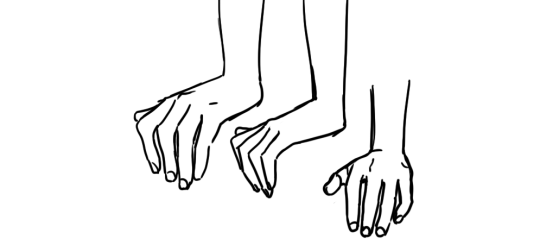
^^^ here is a pose I use a ton. I have a quick way of drawing it from various angles. the first time I had to draw a pose like this, I had to think and figure it out, but in drawing it a bunch of times and having to use various angles like this, I’ve eventually come up with a quick, reliable way to draw it from a few of the most common angles that fits the style I like to draw in. I’m blessed with a good memory for observations, so when I see a beautifully posed hand, I can usually really quickly analyze what I like about that pose and why, and that helps me absorb it so I can recreate my saved impression later. But I know not everyone thinks the same way. it might benefit you to quickly scribble down a study in a sketchbook when you see a pose you find beautiful and want to learn from for later.
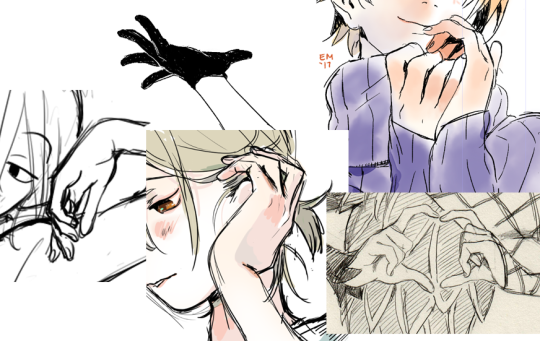
^^^ here are some poses I had to stop and spend time figuring out, calling up the “rules” for how hands are built to kind of logic-out how they should look from angles I’m less familiar with. results can be mixed, but... if I end up with something expressive that fits the style of the rest of the drawing, I’m usually really forgiving of fudged anatomy or slightly wonky proportions. as long as the thumb is on the right side and there aren’t too many fingers, that’s a great start lol.
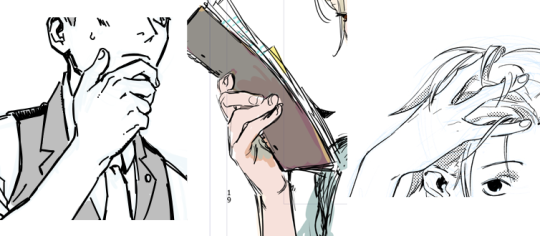
^^^ and here are ones I had to take reference-selfies for. I try to use this as a last resort because 1) it’s a lot of trouble 2) interrupts my drawing and 3) if I’m not careful I stick too close to the reference, and the drawing ends up with the hand looking referenced and the rest of the pose not, which is jarring to me. not to mention I have tiny manlet wrists that without fail, look horrific and emaciated in photos, and the lens distortion makes my fingers look scary too... ugh, photo reference has definite flaws. I actually don’t like the look of drawings for which I can Really Tell the artist drew from photo reference, because most often that means they’re taking the ref too much at face value and incorporating ugly lens distortions into their drawing. so I have to think extra hard not only about interpreting the ref, but also might have to make multiple passes just to get the hand to look normal, AND match the style of the rest of the drawing.
Anyway, here are some of the ““rules””” I mentioned earlier that I fall back on to help me figure out more complicated poses:
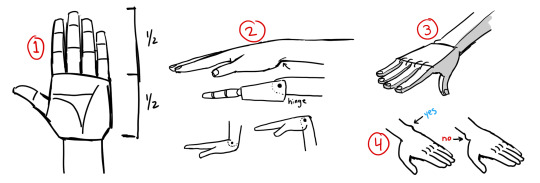
1. probably seen this before, but basic proportions. the palm is usually half the total height of the hand. obviously you can mess with this purposefully.
2. I think of joints as like, ball joints or hinges. I find that easier than trying to remember bones & muscles. here’s a drawing of the wrist as a hinge. note that when you’re thinking of it this way, it’s a shortcut, but a shortcut is only good if you use it with precision. notice the pin for the wrist hinge is not just halfway, it’s closer to the top of the hand. being precise about that is what allows this shortcut to work. the heel of the palm juts out, while the top of the hand transitions into the wrist quite smoothly.
3. simplified planes. planes are important yo. in super simple terms: top is flat, bottom is round. this works on the fingers too, actually. the tops are bony and tendony, and the bottom is where the fat is, so it’s rounder and soft
thinking of the hand as abstract shapes REALLY helps simplify the task of drawing hands, and is just as helpful even if you are drawing from reference. I can say “the palm is a box” and obviously the palm is not really as simple as a box, but if I think of the palm, wrist, and each finger joint as various shapes of box, then all of a sudden, psychologically, my task is SO much easier. I’m not drawing a Hand, which is hard, I’m drawing boxes, which is easy.
4. that prominent knob some people have on their wrist? that’s on the pinky side.
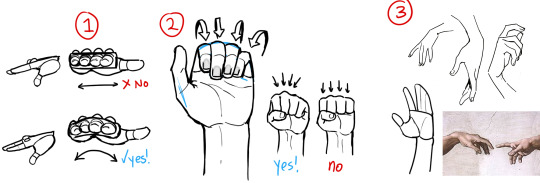
1. the knuckles aren’t really a flat row on top. the hand is like a cup right, so your palm can hold water and things. so we can think of the hand as a box to make figuring out the pose easier, but when it comes down to it, you’ll want to make it more of a curve. this curve is why you can see multiple fingers in a side view
2. when curled up, the fingers nestle together. the fingernails also turn slightly toward the center. even if I’m simplifying the hands significantly, I usually still draw the fingernails because they are SO useful for communicating the pose of the hand effectively.
3. lots of people suggest to think of the hand as a mitten, grouping the pinky/ring/middle fingers and singling out the index finger. this works great, the index finger is more independent from the other three. on the flip side, those three are really stuck together; if you’re drawing the pinky curled up all the way, then you better not draw the ring finger sticking straight up, cause that would HURT. anyway, singling out the index finger leads to more interesting poses in my experience.
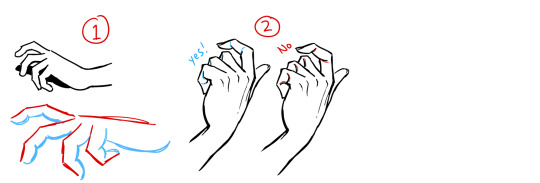
1. this is another illustration of top = flat and bottom = curved. this is a really easy way to organize your line quality. straight lines and sharper angles where there is bone, and soft gentle lines where there is muscle and fat. your drawing as a whole will read very clearly if you find some guidelines like that to stick to, as it means all your lines are intentional and thoughtful.
2. this one’s about overlaps. when forms overlap, it makes a crease, and when you draw that crease you’re communicating which form is in front of the other. in the second drawing I reversed all the creases, and it looks.... messed up. think about how pieces connect.
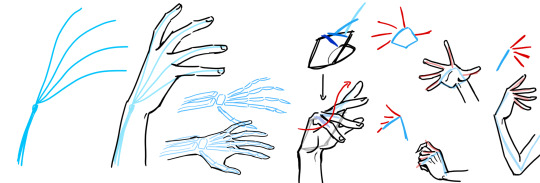
so when you’re trying to make up a pose without using specific reference, I think it’s good to think about the.... flow of energy through the pose. honestly, I know it’s really abstract, but if I have an ability to make interesting poses that communicate weight and movement, the things that make people say your character feels ALIVE, like they really EXIST in a space... it’s because I started to think of poses this way. imagining streams of energy bouncing through the body, flowing down the limbs and out through the fingers. this is why hands are so important to me, cause they’re where the kinetic energy of the pose ultimately ends up. I talk about it when drawing the torso and arms and legs, but an interesting drawing has a bounce back and forth between opposites: for every curve, an opposing straight line, alternating back and forth down the entire body. if you’re sensitive to the energy of the pose, then even very simple poses will be interesting to look at.
anyway, with regards to hands, I imagine the energy getting sort of cinched in as it passes through the wrist, and then emanating out through the fingertips. I hope my drawing at least SORT of communicates this imagery. it makes sense because that’s BASically how the bones in the hand are anyway. and then the right side of the image above is just demonstrating some highly simplified gestures. see how the fingers fan out and curl in, rarely parallel to eachother. when you’re figuring out the pose, using a line to stand in for the row of knuckles is super valuable.
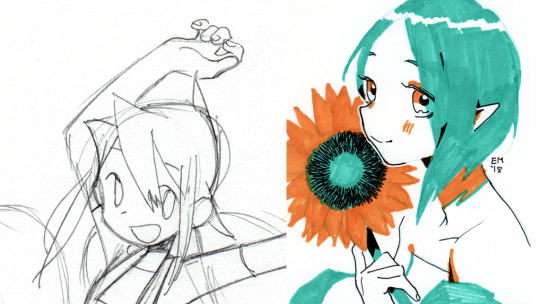
aaand finally, here’s two hands where I intentionally neglected correct anatomy and proportion because I felt it worked better for the style of the whole drawing. Left side: since this is a really simple and cartoonish style, I was thinking back to kids’ and shoujo manga I have read where the style was very solid and distinctive, but definitely NOT overly concerned with correct anatomy, or even really drawing hands, uh, “well” at all. to me, that sort of approach has a Look that I like to invoke sometimes, since for years I felt like I learned a bunch of anatomy and proportion and drawing from life actually in detriment to the liveliness and appealness of my drawings. this hand is mushy and makes very little sense, but it turned out as intended. Right side: sometimes I like to pretend fingers only have 2 bones in them, cause i am a Queen and i do what i want
and there you go. I hope that helped, like, at all? Look at real hands and photos of hands and hands in motion, but also look at drawn hands as well. find what you like, and work towards expressing that yourself. and remember the hand is part of the whole drawing. not only in the art style like I’d been talking about, but because the angle and placement of the hand is reflected in the angles of the arm, which in turn reflects on the angles of the shoulder, which affects the whole torso, etc etc etc. and the techniques you can use to understand and draw the rest of the body, works on hands too. as you improve everything else, your hands will improve as well.
DISCLAIMER: I whipped up these diagrams quickly, they’re not meant to be good drawings or accurate refs, just diagrams to illustrate my thought process lol
3K notes
·
View notes
Note
May I ask an art question? How do you study anatomy and practice? I'm always awestruck when you post a pegasus piece because it's so detailed yet simple, plus you draw horses with no problem so I'm very inspired and afraid of your power.
Hello!
Ahhh thank you!!
Art theory incoming! Brace yoursellllves!
There are 3 main things that I've found work best for me in practicing anatomy/composition/drawing in general:
Timed studies and drawings
Asking "What do I want to say with this drawing?"
Drawing every day
The single most influential thing I was taught about art is that it's not about the drawing or the draftsmanship - it's about the communication.
If you can successfully make someone feel something, or ask a question when looking at your drawing, you've done well.
Draftsmanship does help with that, so I do timed studies (10 min or less) of master paintings, concept art I like, or just photos of interesting animal/human poses to force myself to make decisions more quickly. And, the more you draw, the more you see and can apply. So I try to practice as often as possible.
Doing that has helped me narrow down what's important in each drawing. If you can give an answer to the question "What is your drawing about?" you're halfway there. Then you just have to be judicial about using composition and pose to communicate what the About is.
I'm not always very good at it, and I'm always learning, but that's my general thought process.
I mostly learned that stuff from Chris Oatley, Loish, and Pascal Campion. Those are artists who're extremely effective, and their pieces are full of life and emotion. Other artists who I've studied are Norman Rockwell, J.S. Sargent, and Bill Watterson. They do a FANTASTIC job of selective detail and visual communication.
---
As far as reference goes, I have sort of large Pinterest board for horse reference. It also helps that I own a horse, and have been riding for over 20 years, so I'm pretty familiar with their physical mechanics. I keep one for people, too.
---
My Pinterest boards
Horse Ref
Human Ref
--
Sorry for the rambling!
- Lauren
29 notes
·
View notes